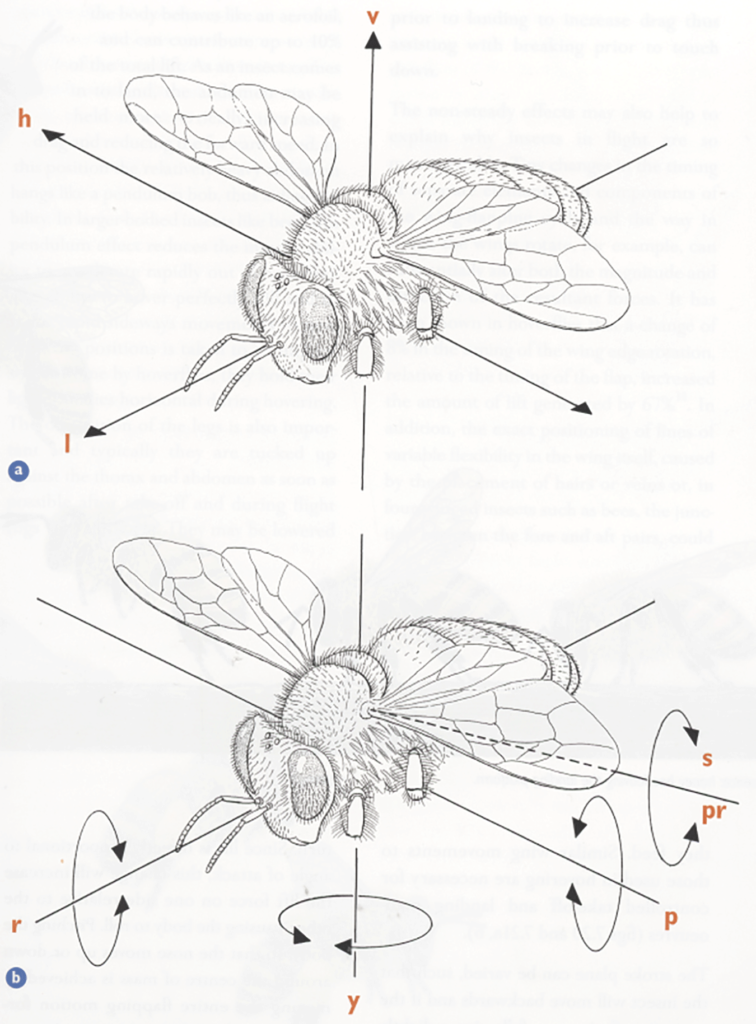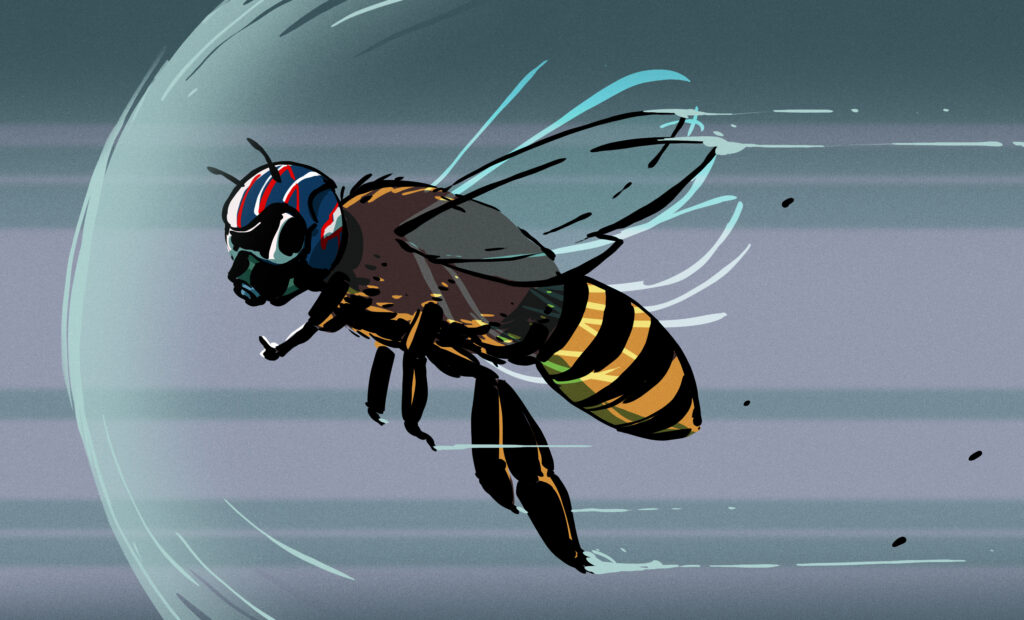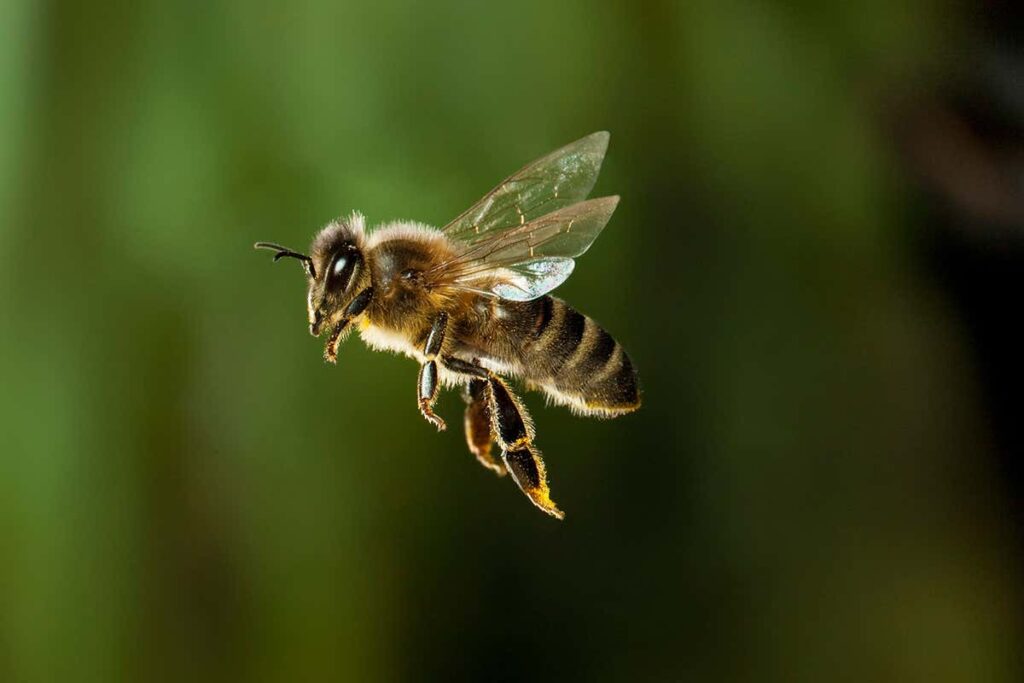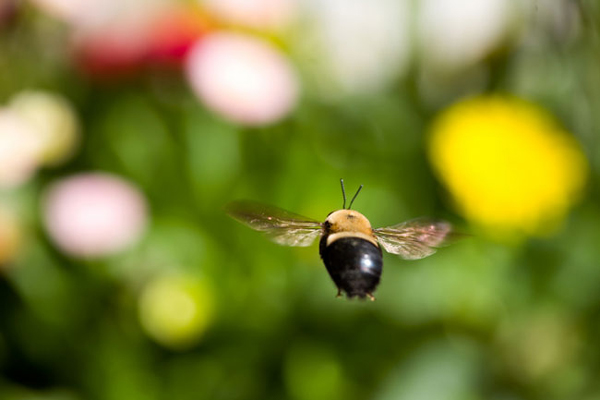
Imagine being able to achieve the seemingly impossible feat of flying effortlessly through the air, defying gravity with every graceful glide. Have you ever wondered how bees, with their delicate wings, are able to accomplish such a magnificent feat? In this article, we will explore the fascinating world of bee aerodynamics, uncovering the secrets behind their remarkable ability to soar through the skies. Prepare to be amazed as we delve into the intricate details of these tiny yet mighty bee wings, unraveling the power of flight like never before.

This image is property of www.beeculture.com.
Wing Structure
Overview of Bee Wing Anatomy
When it comes to the fascinating world of bees, their wings are an essential aspect of their anatomy. Just like other insects, bees have two pairs of wings, making a total of four wings. These wings are attached to the bee’s thorax, which is the middle section of its body. The intricate structure of bee wings enables them to perform various aerodynamic feats necessary for their flight.
Types of Bee Wings
The wings of bees can vary in shape and size, depending on the species. Typically, bee wings are elongated and have a transparent membrane stretched over a framework of veins. However, some species may have slightly different wing shapes, such as narrower wings or longer forewings than hindwings. These variations in wing morphology are thought to contribute to the diverse flight capabilities of different bee species.
Wing Flexibility
One remarkable aspect of bee wings is their flexibility. Bee wings are incredibly agile, allowing bees to adjust their wing shape during flight. This flexibility is crucial for maneuverability and adjusting flight speed. The ability of bee wings to change the angle of attack and adjust their shape helps bees maintain stability and control during flight. The elasticity of their wings enables bees to optimize their flight performance in various environmental conditions.
Wingbeat Frequency
How Bees Generate Wingbeat
Bees are known for their rapid wingbeats, which enable their impressive flight capabilities. The mechanism behind bee wingbeat lies in the contraction and relaxation of muscles attached to the wing base. The rapid contraction of these muscles causes the wings to move rapidly up and down, generating the necessary lift for flight. The coordinated movement of the two wings allows bees to achieve stable and efficient flight.
Relationship between Wingbeat Frequency and Flight Speed
The wingbeat frequency of bees varies depending on the flight speed. As bees increase their flight speed, they also increase their wingbeat frequency. This relationship between wingbeat frequency and flight speed allows bees to adapt to different environmental conditions and achieve optimal flight performance. The ability to modulate wingbeat frequency is crucial for bees to navigate their surroundings and efficiently forage for resources.
Variations in Wingbeat Frequency among Bee Species
Different bee species exhibit variations in their wingbeat frequency. Some species have high wingbeat frequencies, allowing them to achieve fast flight speeds. On the other hand, certain bee species have slower wingbeat frequencies, suited to their specific ecological needs. These variations in wingbeat frequency reflect the adaptations of different bee species to their respective environments.
Lift and Drag Forces
Lift Generation in Bee Wings
Bee wings play a vital role in generating lift, allowing bees to stay airborne. Lift force is created when the flow of air over the wings creates a pressure difference. The unique shape and angle of bee wings enable them to generate lift efficiently. As bees move their wings up and down during flight, the wings generate lift by creating areas of higher and lower pressure. This lift force counteracts the force of gravity and keeps bees airborne.
Role of Wing Shape in Lift Production
The shape of bee wings plays a crucial role in lift production. Bee wings are designed with a distinctive curved shape known as camber, which contributes to lift generation. The curved upper surface of the wings, combined with the flatter lower surface, creates pressure differences that generate lift. The cambered shape of bee wings allows for efficient and sustained flight, enabling bees to navigate their surroundings with precision.
Drag and its Impact on Bee Flight
While lift is essential for flight, bees also experience another aerodynamic force known as drag. Drag is the resistance encountered as bees move through the air. Bee wings need to overcome drag in order to achieve efficient flight. To reduce drag, bee wings have evolved to be streamlined and have a smooth surface. By minimizing drag, bees can optimize their flight performance and conserve energy during long-distance flights.
Wing Ventilation
Importance of Wing Ventilation for Bee Flight
Wing ventilation is a critical aspect of bee flight physiology. During flight, bees generate heat through the contraction of flight muscles, and this heat can accumulate in their thorax. Wing ventilation helps dissipate excess heat and maintain optimal flight conditions. Adequate wing ventilation is essential for bees to prevent overheating and ensure efficient flight performance.
Mechanisms of Wing Ventilation
Bees employ two primary mechanisms for wing ventilation: convection and aspiration. Convection ventilation involves the movement of air over the wings, which aids in dissipating heat. Aspiration ventilation occurs when bees actively pump air into their flight muscles, cooling them down. These ventilation mechanisms work in tandem to regulate the temperature of bee wings, enabling sustained flight even in warmer environments.
Wing Ventilation Efficiency and Flight Performance
The efficiency of wing ventilation directly impacts bee flight performance. Bees with more efficient ventilation mechanisms can maintain lower body temperatures and, consequently, exhibit enhanced flight capabilities. Efficient wing ventilation enables bees to fly for more extended periods, withstand challenging weather conditions, and navigate their environment effectively. The ability to optimize wing ventilation contributes to the overall success of bee flight.

This image is property of hackaday.com.
Bee Wing Adaptations
Wing Modifications for Efficient Flight
Over millions of years of evolution, bees have developed various wing modifications to enhance their flight efficiency. These modifications include changes in wing shape, size, and venation patterns. Some bee species have narrower wings, allowing for faster flight speeds, while others have broader wings for improved maneuverability. These wing adaptations allow bees to exploit different ecological niches and exhibit specialized flight behaviors.
Cambering and its Effect on Bee Flight
Cambering is a crucial adaptation seen in bee wings. The curved shape of bee wings, with a convex upper surface and a flatter lower surface, creates a pressure gradient that generates lift. Cambering significantly contributes to the production of lift, stability, and overall flight efficiency. Bees have honed this adaptation to perfection, enabling them to perform intricate flight maneuvers and maintain stable flight in various conditions.
Wing Surface Modifications for Reduced Drag
Minimizing drag is another important aspect of bee wing adaptations. Bee wings have evolved to have a smooth and flat surface, reducing the drag caused by turbulence. Additionally, microstructures on the wing surface, such as tiny hairs or scales, further contribute to drag reduction. These adaptations allow bees to achieve streamlined flight and maximize their aerodynamic efficiency.
Wing Kinematics
Shape and Movement of Bee Wings during Flight
Bee wings exhibit complex and intricate movements during flight. As bees beat their wings, they undergo multiple shape changes that facilitate different flight phases. The wings move in a figure-eight pattern, with the upstroke and downstroke generating distinct aerodynamic forces. These shape and movement changes are vital for the production of lift, thrust, and control during bee flight.
Wing Stroke Patterns
The stroke pattern of bee wings can differ among species and flight phases. Bees typically exhibit higher wingbeats during hovering or slow flight, while their wingbeats become more rapid during faster forward flight. The precise coordination between the four wings ensures efficient lift production and controlled flight maneuvers. The stroke patterns of bee wings are a testament to their intricate flight adaptations.
Wing Kinematics and Flight Maneuverability
The kinematics of bee wings contribute to their maneuverability in flight. Bees can adjust their wing motions, altering the direction and magnitude of aerodynamic forces produced. This flexibility allows bees to perform intricate maneuvers such as hovering, sharp turns, and rapid changes in flight speed. Wing kinematics and the ability to modulate wing motions provide bees with remarkable flight agility and adaptability to their surroundings.

This image is property of images.newscientist.com.
Wing Sensors
Sensory Organs in Bee Wings
Bee wings are not just passive structures for flight; they also house sensory organs that provide essential feedback for flight control. Mechanoreceptors, called campaniform sensilla, are located on the wing veins and respond to mechanical stimuli and wing deformations. These sensory organs allow bees to detect changes in wing movements, air currents, and vibrations, providing critical information for flight control and stability.
Their Role in Flight Control and Stability
The sensory organs in bee wings play a crucial role in flight control and stability. By sensing wing movements and deformations, bees can adjust their flight posture and make necessary corrections to maintain stable flight. These sensory inputs contribute to the fine-tuning of wingbeats, wing posture adjustments, and overall flight stability. The integration of sensory feedback from wing sensors helps bees navigate their environment with remarkable precision.
Wing Sensor Adaptations for Navigational Skills
Bees’ wing sensors have specialized adaptations that aid in their navigational skills. They can detect changes in air currents and vibrations, allowing bees to navigate using landmarks, such as visual cues or scent trails. Wing sensors also play a vital role in maintaining position within the honeybee colony, helping bees maintain their social structure and coordinate collective flight behaviors. The specialized adaptations of wing sensors enable bees to excel in navigation, resource gathering, and complex social interactions.
Bee Flight Performance
Speed and Agility of Bee Flight
Bees are renowned for their impressive flight capabilities, exhibiting both speed and agility. Different bee species have varying flight speeds, ranging from a few miles per hour to over twenty miles per hour. The rapid wingbeat frequency and precise wing kinematics allow bees to achieve these remarkable speeds. The agility of bee flight enables them to navigate complex environments, avoid obstacles, and exploit floral resources efficiently.
Optimized Flight Strategies for Foraging
Foraging is a crucial aspect of a bee’s life, and their flight strategies are optimized to maximize resource gathering. Bees utilize efficient flight patterns, such as straight-line flights between food sources and the hive, or complex search patterns when locating new resources. The ability to modulate flight speed, wingbeat frequency, and wing kinematics allows bees to adapt their flight strategies to diverse foraging conditions, ensuring a successful and efficient foraging process.
Effects of Environmental Factors on Bee Flight
Bee flight is influenced by various environmental factors. Temperature, humidity, wind speed, and air density all impact the flight performance of bees. Extreme weather conditions, such as strong winds or high temperatures, can pose challenges for bees’ flight capabilities. However, bees have evolved physiological and behavioral adaptations to cope with different environmental conditions, ensuring successful flight and maintenance of their essential ecological roles.

This image is property of media.springernature.com.
Aerodynamic Efficiency
Bee Wings as Efficient Flying Machines
Bee wings are remarkable examples of aerodynamic efficiency in nature. Through years of evolution, bees have optimized their wing shape, flexibility, and kinematics to achieve efficient flight. The cambered shape and streamlining of their wings reduce drag, while the ability to adjust wing motions and modulate wingbeat frequency allows for precise control and maneuverability. The combination of these adaptations results in bees being highly efficient flying machines.
Comparison to Other Insect Wings
Compared to other insect wings, bee wings possess unique adaptations that differentiate them aerodynamically. Each insect species, including bees, has evolved specific adaptations to suit their flight needs. For instance, butterflies have large wings for slow and graceful flight, while dragonflies have powerful wings for agile maneuverability. Bee wings have their own specialized adaptations, allowing them to excel in their ecological niches and perform their essential pollination duties.
Lessons from Bee Wings for Engineering Applications
The study of bee wing aerodynamics has provided valuable insights for engineering applications. By understanding the intricate adaptations of bee wings, engineers can design efficient flying machines, such as micro aerial vehicles (MAVs) or drones. Bee wings have served as inspiration for the development of flapping-wing mechanisms and the optimization of flight control systems. The lessons learned from bee wings contribute to advancements in aerospace technology and robotics.
Future Research Directions
Advances in Studying Bee Wing Aerodynamics
Continued research on bee wing aerodynamics holds immense potential for further discoveries. Advanced imaging techniques, such as high-speed photography and computational modeling, allow for detailed analysis of wing movements and airflow patterns. With these tools, scientists can delve deeper into the complexities of bee wing aerodynamics and gain a more comprehensive understanding of their flight capabilities. Ongoing research will continue to unveil new insights into the remarkable adaptations and flight performance of bees.
Unanswered Questions and Areas for Further Exploration
While significant progress has been made in studying bee wing aerodynamics, there are still unanswered questions and areas for further exploration. Researchers aim to uncover the precise mechanisms of wingbeat generation and the interplay between wing morphology, kinematics, and flight performance. Additionally, understanding the impacts of environmental factors, such as climate change, on bee flight is an important avenue for future research. Exploring these unanswered questions will deepen our knowledge of bee flight and its ecological significance.
Potential Applications of Bee Wing Research
The knowledge gained from studying bee wing aerodynamics has diverse potential applications. Understanding the flight mechanisms of bees can aid in the development of efficient flying robots, improving areas such as search and rescue operations or pollination services. Furthermore, the insights gained can inform the design of more efficient aircraft, reducing energy consumption and environmental impact. As research continues, the applications of bee wing research have the potential to revolutionize various industries and positively impact our lives.
In conclusion, the aerodynamics of bee wings are a captivating subject of study. Their intricate structure, unique adaptations, and remarkable flight capabilities have fascinated scientists and entomologists for centuries. The comprehensive exploration of bee wing anatomy, wingbeat frequency, lift and drag forces, wing ventilation, adaptations, kinematics, wing sensors, flight performance, aerodynamic efficiency, and future research directions contribute to our understanding of the power of flight in bees. By unraveling the secrets of bee wing aerodynamics, we gain not only insights into the fascinating world of bees but also inspiration for the development of new technologies and engineering solutions.

This image is property of cdn.mos.cms.futurecdn.net.